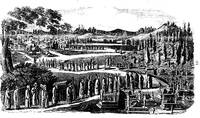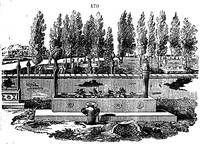334. Cemeteries. The Turkish burying-grounds are generally favourite places of public resort. The principal promenade in the evening, for the inhabitants of Pera, is a very extensive cemetery, which slopes to the harbour, is planted with noble cypresses, and is thickly set in many places with Turkish monuments. The opulent Turks have their graves railed in, and often a building over them, in some of which lights are kept constantly burning. The inscription on the headstones is usually a sentence from the Koran, written in letters of gold. The Turks, like the Welsh, adorn the graves of their friends by planting flowers upon them, generally the myrtle, but sometimes the amaryllis (fig. 170.). (Williams's Travels, &c., p. 201.) The vicinity of a cemetery is not in the capital of Turkey judged by any means disagreeable, and no spot is so lively and well frequented as the Armenian and Frank burying-ground, at the outskirts of Pera, called Mnemata, or the tombs. It is shaded by a grove of mulberry trees, and is on the edge of some high ground, whence there is a magnificent view of the suburb of Scutari and a great portion of the Bosphorus. (Hobhouse's Travels in Albania, vol. ii. p. 837.) The cemetery of the Turks, at Constantinople, is the fashionable quarter of the Franks, and the pleasure-ground of the Levantines. It is the only place of recreation in Pera. (Madden's Turkey, p. 204.) The Turkish cemeteries are generally out of the city, on rising ground, planted with cedars, cypresses, and odoriferous shrubs, whose deep verdure and graceful forms bending in every breeze, give a melancholy beauty to the place, and excite sentiments very congenial to its destination. (Eustace's Travels, &c., p. 513.) The cemetery of Eyub or Ayoub, near Constantinople, is crowded with graves; those which contain males have generally a turban at the head of the flat tombstone, and nearly all have plants growing from the centre of the stones (fig. 171.). The Mosque of Ayoub, adjoining this cemetery, is held so sacred that no Christian, on any pretence whatever, is allowed to approach it. It takes its name from Ayoub or Job, the standard-bearer of the prophet Mahomet, who was killed in 688 at the first siege of Constantinople by the Saracens. 'It is a beautiful and picturesque old building in the centre of a marble square with a fountain, and surrounded by superb trees, among which two planes, especially, and a horse-chestnut, are of a size almost incredible. The high hills beyond are covered with forest trees, cypresses, and tombstones, as thick as they can be placed.' (Narrative of a Yacht Voyage in the Mediterranean.) The magnificent burial-ground of Scutari extends for miles in length, and among high and turbaned tombstones, with gold-lettered inscriptions, mournful cypresses are thickly planted. (Alexander's Travels from India, p. 240.) The street of tombs is so called from its being entirely bordered with gardens containing the tombs of sultans, saints, and great people, very magnificent and richly gilded. Some of the tombs, particularly those of the sultanas, are covered with aviary-like frames of golden wire, and surrounded with flowers and plants. There were also some regular mausoleums, like those in other parts of the city, shaded by fine trees, and well supplied with fountains. The stillness and melancholy magnificence of this street are very impressive, and congenial to its high and solemn destination.' (Voyage in the Mediterranean, p. 341.) A very large burying-ground, shaded by an extensive forest of cypresses at Bournabat, a village of elegant country houses built in the European fashion, belonging to the merchants of Smyrna. (Hobhouse's Travels in Albania, vol. i. p. 640.) The hills on the side of the modern Chrysopolis are, for some height, one cemetery, or forest of cypresses. The prediction which foretells the subjection of Constantinople to a white or yellow-haired nation has gained credit during the last century; and the Mussulmen who choose a more secure repository for their ashes prefer the burying-grounds on the Asiatic banks of the Bosphorus to those of the capital. On the top of the hill Bongalon is a.fountain of clear water, much esteemed at Constantinople, and the country upon the declivity of the hill is covered with gardens, melon-grounds, and vineyards, supplying the capital with fruit. Northwards the ground is also well cultivated, and divided by hedgerows, frequent avenues, and clumps of trees. (Ibid.) The Jewish burying-ground. There is a considerable space, unoccupied by any houses, between the suburbs and the summit of the hill, and this is allotted for a burying-ground to the Jews, who have nearly covered it with their tombstones, lying flat on the ground, and not raised in the manner usual in our churchyards. A little to the north-east of the Jews' burying-ground, and also on the side of the castle hill, is a Turkish cemetery, which Mr. Hobhouse declares to be the most crowded he ever saw, and which is walled in, and shaded by a thick forest of cypresses. (Ibid., p. 623.) The Necropolis of the ancient city of Byzantium was near the Bosphorus, on the north and north-west of the buildings, which do not ever appear to have extended close to the water in that direction. There are here still remaining many ancient sepulchres hewn out of the rock. These are descended to by flights of steps, like those south of Tartooze, when a square and sometimes an arched door leads to dark chambers, in which the sarcophagi were deposited in cells in the usual way. The rocks here seem also to have formed the quarries for the buildings of the living, as appearances of that kind are seen all around. The environs of Ladakea have many olive-grounds, gardens, little country retreats, and places of pleasure; the inhabitants are all fond of rural recreation; and those who cannot find time for a longer excursion, seat themselves along the sides of the public roads, both in the morning and in the evening, to enjoy the freshness of the air, and as they themselves say, to lengthen out their days by delight. (Buckingham's Travels among the Arab Tribes, p. 535.) The work of Pausanias informs us that a number of tombs of the illustrious dead were in the vicinity of Athens; many of them in the gardens. Very few, however, still remain. (Hobhouse's Travels in Albania.) The burial-places of the Turks at Smyrna are varied by cypresses, and anemones and other gay flowers are frequently planted on the graves. (Swan's Voyage up the Mediterranean, p. 132.)



